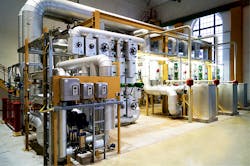Most district-energy systems in the United States are steam-based and, as such, utilize shell-and-tube or gasket-plate-heat-exchanger (GPHE) technologies to transfer hot water to building substations. Both shell-and-tube and GPHE technologies, however, possess operational shortcomings that prevent systems from operating at their full cost-effectiveness and efficiency.
The design of shell-and-tube heat exchangers does not allow for the most efficient transfer of heating or cooling energy in hot-water-based systems. Also, they are difficult to clean and maintain, as the entire tube nest needs to be removed, which can be difficult when space is tight.
The main drawbacks of GPHEs concern the gaskets, which need to be changed. A number of conditions, including wear, which can be caused by heat, temperature fluctuations, or cleaning, can necessitate the changing of a gasket. When gaskets age or fail, they leak, which can lead to additional costs for maintenance, replacement, or, in severe cases, cleanup.
One common shortcoming of both shell-and-tube heat exchangers and GPHEs is their large size. This can be a drawback when space is at a premium.
While the current installed base of district-energy systems in the United States relies on shell-and-tube heat exchangers and GPHEs, an alternative technology is gaining in prominence. The brazed-plate heat exchanger (BPHE) has none of the operational red flags shell-and-tube heat exchangers and GPHEs possess and easily can replace either technology in a district-energy system retrofitted to be powered by hot or chilled water, rather than steam.
Operational advantages of BPHEs include:
- Compact size. BPHEs are extremely compact compared with other heat-exchanger technologies. They can be 1/10th the size of a shell-and-tube heat exchanger and half the size and weight of a GPHE. This allows engineering rooms to be used for other purposes while reducing costs and carbon emissions.
- Efficiency. With no need for gaskets or supporting equipment, about 95 percent of the material in a BPHE is used to transfer heat, while the highly turbulent flow created by the corrugated channels enables small temperature differences in the media to be used most efficiently.
- Reliability. The absence of gaskets eliminates the risk of media leakage while guaranteeing stable thermal and hydraulic performance with minimal maintenance and operational downtime.
- Flexibility. The compact size of BPHEs allows installation space to be used more efficiently, resulting in the ability to incorporate more flexible system designs. Additionally, larger systems can be installed unit by unit, which eases the installation process and simplifies capacity expansion when demand increases.
- Cost-effectiveness. The life-cycle (15 to 20 years) cost of BPHEs, including energy, maintenance, spare parts, and labor, can be half that of systems utilizing GPHEs.
- Self-cleaning. Because of their turbulent flows, many BPHEs are self-cleaning, even when water quality is a concern. BPHEs’ clean-in-place (CIP) ability enables maintenance without disassembly. CIP can be executed through a simple setup.
- Customization. Because of their compact size and versatility, BPHEs can be combined with standard district-energy-system components to create a solution that can meet the specific needs of end users.
Fit for the Job
To some, the compact size of the BPHE meant the technology could not reach the higher load capacities required in larger district-energy systems. That no longer is a concern, as BPHEs are being designed with higher capacities, all with the goal of improving their operational effectiveness when utilized in district-energy systems.
Through design enhancements, a single BPHE can produce up to 30.7 MBtuh (9 MW) of heating or 426.5 TR (1.5 MW) of cooling with a 6-in. port size. In a setup featuring a modular configuration, a series of BPHEs of this size can be used to meet a facility’s specific heating or cooling needs. Higher-capacity BPHEs have a standard pressure rating of 25 bar (363 psi). This is a realm in which GPHEs traditionally have been preferred, but this capability, combined with a smaller footprint, CIP capability, and more efficient heat transfer, makes the BPHE a viable alternative.
Conclusion
The benefits of a district-energy heating and cooling system have become more widely acknowledged in North America thanks to the growth of combined heat and power and a change to hot-water-based systems. For existing installations that are ready for a retrofit, the switch can be eased and optimized if BPHEs are selected as the conduit to efficient, cost-effective heat transfer. Compact and gasket-free, BPHEs offer reliable performance, even at high capacities. When they are correctly dimensioned, BPHEs can provide more stable control, lower life-cycle costs, and a higher rate of return in district-energy heating and cooling systems.
Pär Björkman is segment manager for district energy and residential heating for SWEP International AB, supplier of brazed-plate heat exchangers for HVAC (district energy, residential heating, air conditioning, refrigeration) and industrial (energy, process and production, temperature control, marine and transport) uses. He can be reached at [email protected].













